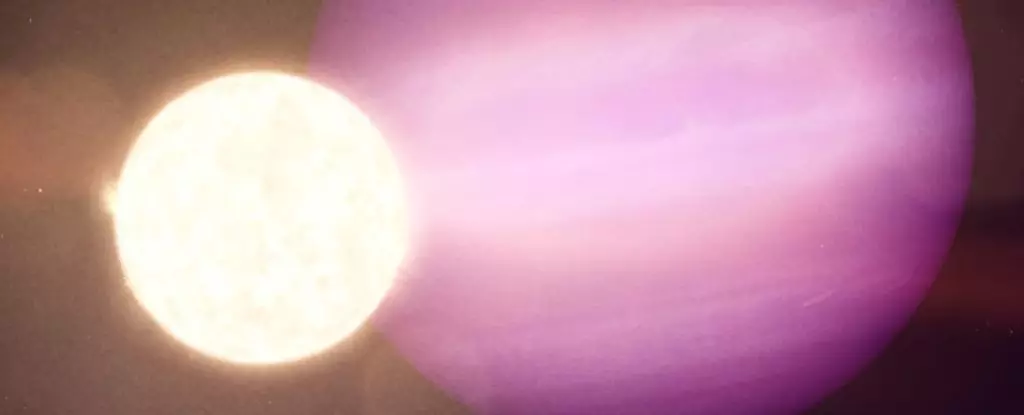In the expansive theatre of the cosmos, the discovery of WD 1856+534 b stands out as a pivotal moment in our understanding of planetary systems. Detected in 2020, this super-Jupiter exoplanet, which boasts a mass approximately six times that of Jupiter, orbits a white dwarf star located an impressive 81 light-years away from our planet. Not only is this behemoth notable for its size, but it has also taken the title of the coldest exoplanet detected so far, stirring excitement among astronomers and astrobiologists alike.
Recent investigations conducted by an international consortium of experts have harnessed the advanced capabilities of the James Webb Space Telescope (JWST), particularly its Mid-Infrared Instrument (MIRI). This remarkable tool allowed researchers to delve deeper into the planet’s characteristics, uncovering critical aspects of its nature and the mystery of its orbit. This collaborative effort, led by the brilliant Mary Anne Limbach from the University of Michigan, included contributions from prestigious institutions such as MIT, Johns Hopkins University, and the University of Texas at Austin.
The JWST: A Game-Changer in Exoplanet Research
The JWST is revolutionizing our exploration of exoplanets through techniques such as Direct Imaging. With its state-of-the-art infrared optics, the telescope provides a means to observe the light reflected from exoplanet surfaces or atmospheres. This allows scientists to search for chemical markers indicative of potential biosignatures, including critical elements such as oxygen and methane. This process could eventually lead to the historic detection of extraterrestrial life beyond our Solar System.
Despite the optimistic projections, the challenge of separating the faint light from an exoplanet from the overwhelming brightness of its host star has limited the scope of direct imaging. Thus far, only large gas giants with substantial orbits or elevated atmospheric temperatures have been observed using this method. In contrast, smaller terrestrial planets and their cooler counterparts have remained elusive, reinforcing the need for innovative approaches in the study of these celestial bodies.
However, the allure of WD stars, like the one that anchors WD 1856+534 b, continues to captivate scientists. These stellar remnants uniquely offer opportunities to observe much colder planets, as their low luminosity helps mitigate contrast challenges faced during direct detections. Understanding these planets and their survival following a star’s main-sequence phase can provide vital clues about the future of planetary systems, including the stability of their orbits and the potential for habitability in the cosmos.
The Coldest Exoplanet: WD 1856+534 b’s Surprising Findings
Through meticulous observations, the research team confirmed the presence of WD 1856+534 b utilizing the infrared excess method, revealing a chilling average temperature of 186 Kelvin (-87°C or -125°F). This discovery not only cements its status as the coldest exoplanet known but also underscores its unique position within the cosmos. Additionally, they found that the exoplanet has a mass constrained to no more than six Jupiter masses, a significant departure from previous estimates which projected a heftier mass of 13.8 Jupiter masses.
This groundbreaking confirmation introduces new narratives into the dialogue concerning the survivability of planets around white dwarfs. It raises vital questions about the behavior of such planetary bodies as they interact with their host stars throughout the different stages of stellar evolution. Can conditions for habitability persist after the main sequence? Can planets survive the dynamic turmoil often surrounding their stars’ transition into white dwarfs?
A Future Teeming with Questions and Endless Possibilities
As astronomers and astrobiologists set their sights on the upcoming observations scheduled for 2025, optimism is palpable within the scientific community. The anticipated data will not only enhance our understanding of WD 1856 b but may also unveil additional planets in the same system. The insights gleaned from these observations could help elucidate whether WD 1856 b’s current orbit is a result of perturbation—an essential aspect in piecing together the puzzle of planetary migration and stability.
Moreover, data gathered from the JWST’s earlier observations using the Near-Infrared Spectronometer (NIRSpec) is soon to be released, priming researchers for further characterization of WD 1856 b’s atmosphere. The confluence of these discoveries is positioned to redefine the scope of exoplanet studies. This frontier holds tantalizing possibilities, not only about the conditions conducive to life beyond our Earth but also about the intricate dance of celestial entities that have withstood the test of time in a vastly evolving universe.
The quest to understand planets like WD 1856+534 b is a journey into the unknown that thrills both astronomers and laypeople alike. Each revelation spurs us to ponder the depths of existence, compelling us to wonder what lies beyond our blue planet, waiting to be discovered.


Leave a Reply